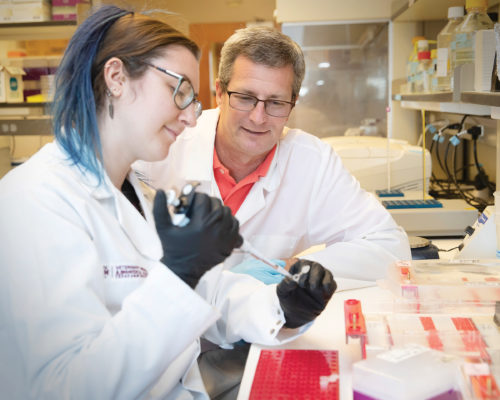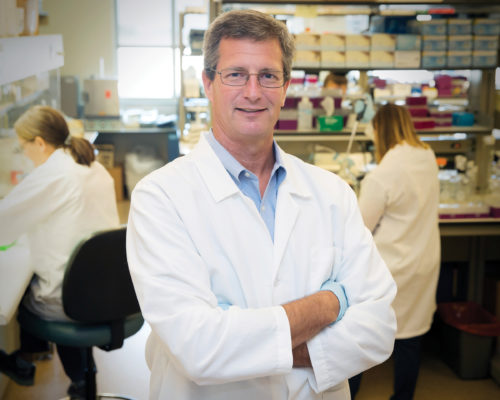Holy Cow!
Comparative immunologist Michael Criscitiello and a team of researchers from across the country are using “special” cattle antibodies to make medical breakthroughs in the areas of HIV and, hopefully soon, triple-negative breast cancer.
Story by Jennifer Gauntt
“Cows do neat things,” said Michael Criscitiello, an associate professor in the Texas A&M College of Veterinary Medicine & Biomedical Sciences’ (CVM) Department of Veterinary Pathobiology (VTPB), as he sat in his office one Friday afternoon.
For the past six years, Criscitiello has been taking advantage of, arguably, one of the neatest things that cows can do.
Using “special antibodies” that cows naturally produce, Criscitiello and a team of researchers (including at Scripps Research Institute) have made significant headway in HIV research by eliciting broadly neutralizing antibodies to the virus that biomedical engineers in California and New York believe may hold a key for HIV vaccines, therapeutics, or other prevention tools.
While that project has advanced into the human medicine realm, Criscitiello and another team, including master’s student Kelly Head, are now turning their attention to using these same antibodies in a way they hope might one day be used to create an immunological treatment for breast cancer.

HITTING THE BULLSEYE
Both projects began by immunizing a cow.
A comparative immunologist who has devoted his career to studying “weird” antibodies in vertebrates—including sharks and frogs—Criscitiello observed a remarkable phenomenon that appears in cattle antibodies.
“About 15 percent of cow antibodies have this extra finger-like projection; we call it an extra domain of the protein that’s not in our antibodies,” he said. These projections are called heavy chain complementarity-determining region 3, or HCDR3 loops.
While humans don’t have the immunogenetic tools to make HCDR3 in our genome, HIV researchers found that 10 to 20 percent of people living with HIV do, indeed, naturally develop neutralizing antibody responses similar to HCDR3, but usually only after nearly two years of infection.
The human forms of the projections have been shown in the laboratory to stop most HIV strains from infecting human cells and to protect animal models from infection, which occurs when the antibody projection binds to the gp120 antigen of the virus that it uses to attach to the host white blood cell.
Using this research as a frame of reference, and noticing how cow antibodies have this much, much longer extension, Criscitiello and his team postulated that this HCDR3 loop could possibly bind to the virus more effectively.
“In a nutshell, the cow can make an antibody that can reach a part of the virus that our antibodies normally can’t,” Criscitiello said.
In order to test the theory that these broadly neutralizing antibodies (which include the HCDR3 loop) could potentially serve as a pathway to produce an immunological therapy, or possibly even a vaccine, for HIV, researchers would need more of these broadly neutralizing antibodies and they would need them to be produced rapidly, at a scale suitable for widespread distribution.
So, Criscitiello and a team at Texas A&M went to work, immunizing cows with a protein designed to mimic an HIV surface protein to see if the cow would produce an immunological response, creating antibodies with these HCDR3 loops.
“What was exciting was that we found that the cows didn’t just make a good antibody; they made lots of antibodies, and those antibodies bound not just some HIV very well but they were broadly neutralizing all different forms of the virus from all over the world,” Criscitiello said.
In addition, the cattle produced those antibodies a lot faster than the team had anticipated.
“Usually, it takes six to eight months (to see an immunological response), because we give them boosters, the way you do with some vaccines,” Criscitiello said. “But we actually had really good antibodies in a couple months.”
Since the team published their results, medical engineering companies have picked up the research, using DNA cloning that attempts to take the part of the cattle gene that produces the HCDR3 loops and put that piece of DNA into a human antibody-heavy chain.
The result, he says, would likely be a therapy to serve as “first line of defense,” but the therapy would be an immunological therapy instead of a medical treatment. A lot of testing will go into the clinical intervention stage, but Criscitiello says the research is promising.
“This is exciting for our lab, as our work is generally on more fundamental immunology questions and takes longer to be applied into therapeutic interventions,” Criscitiello said.

TAKING THE BULL BY THE HORNS
Following their success, Criscitiello and his team returned to their basic science approach of research, re-examining the cow’s immune system to delve deeper into the genetics behind their immunity.
But because the team had been tinkering with other diseases in similar projects (including one on Ebola) before the HIV breakthrough, when Scripps Research collaborator Vaughn Smider shared with Criscitiello that the Scripps team was working on a project on breast cancer, they wondered if what had worked in their HIV study could potentially work with Smider’s project.
“The HIV project excited us to try for more things and, in this case, it’s kind of a personal story,” Criscitiello said. “Vaughn’s wife had died of this particular kind of breast cancer, triple-negative, and so looking for new avenues for immune-therapeutics for that disease was high on his priority list.”
A particularly tricky form of cancer, triple-negative breast cancer derives its name from testing negative for three important receptors that are usually good handles for clinical intervention—estrogen, progesterone, and HER2. About 10 to 20 percent of breast cancers that are diagnosed in the United States are found to be triple-negative.
“This is a particularly bad diagnosis. If you’re triple-negative, the prognosis is much worse, and if it’s metastatic disease, the median survival is less than a year,” he said. “It’s a bad subset of breast cancer.”
While the HIV project received funding from the National Institutes of Health (NIH), this project is not yet funded, but this team plans to take the same approach as in the previous study—immunizing cattle with the triple-negative cancer cells in hopes that the cattle produce the same HCDR3 response. The team will also analyze the different proteins produced to see what happens.
“Hopefully the cow’s immune system will go, ‘Oh, this is foreign. This is weird. Let’s make some immune responses to these different proteins that we’re seeing,’” Criscitiello said.
While the HIV response produced the right antigens within a couple of months, for this project, the team will have to wait and see. They’re hoping to see the results they’re looking for within a year.
“Ours is a discovery science kind of approach, where we know the cow, we’ve proven that the cow can do some neat tricks with its antibodies, and we know that there are targets on triple-negative breast cancer that we haven’t been able to get a good handle on so far,” he said. “So, we’re going to let the cow immune system do its magic and then analyze the cells that are making those antibodies and try to pull out the ones that bind the triple negative breast cancer.
“We know that some will bind; whether some will use their special HCDR3 loop to bind well enough to make an immune-therapeutic monoclonal antibody to treat at the cancer clinic, that’ll be the question,” he said.
###
Note: This story originally appeared in the 2019 Spring edition of CVM Today.
For more information about the Texas A&M College of Veterinary Medicine & Biomedical Sciences, please visit our website at vetmed.tamu.edu or join us on Facebook, Instagram, and Twitter.
Contact Information: Jennifer Gauntt, Interim Director of Communications, Media & Public Relations, Texas A&M College of Veterinary Medicine & Biomedical Science; jgauntt@cvm.tamu.edu; 979-862-4216


